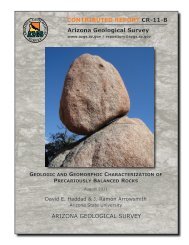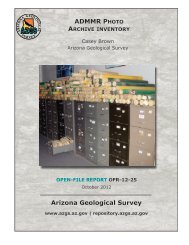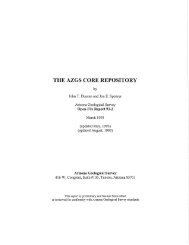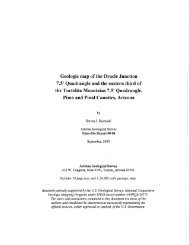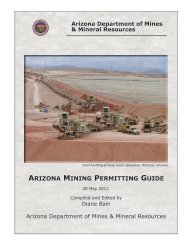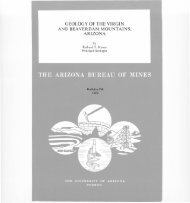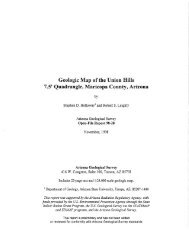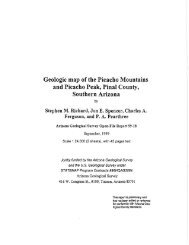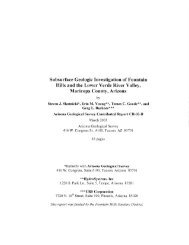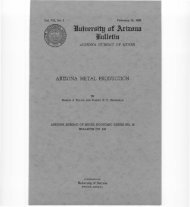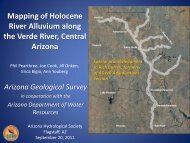Arizona has Salt! - 41 p. - AZGS Document Repository
Arizona has Salt! - 41 p. - AZGS Document Repository
Arizona has Salt! - 41 p. - AZGS Document Repository
You also want an ePaper? Increase the reach of your titles
YUMPU automatically turns print PDFs into web optimized ePapers that Google loves.
White Mountains<br />
Colorado Plateau<br />
The White Mountains are in southern Apache<br />
County about 20 miles south ofthe southern edge ofthe<br />
well-known Holbrook salt basin (Figure 5). Rauzi<br />
(1996) pointed out the possible presence of a concealed<br />
evaporite basin beneath the White Mountains in eastcentral<br />
<strong>Arizona</strong>. Evidence for the possible White<br />
Mountain evaporite basin includes (1) a thick sabkha<br />
sequence of anhydrite and dolomite in the Alpine<br />
Federal core hole east of the basin, (2) numerous salt<br />
springs in the Gila and <strong>Salt</strong> River drainages west of the<br />
basin, and (3) a distinct gravity low between the two. The<br />
-26 milligal residual-gravity contour on the Clifton and<br />
St. Johns Sheets ofLysonksi, Aiken, and Sumner (1981)<br />
suggests an evaporite basin about 70 miles long and 55<br />
miles wide totally concealed beneath the volcanic rocks<br />
of the White Mountains. Erosion of the westernmost<br />
edge of the concealed White Mountains salt basin may<br />
have contributed to the accumulation of the large salt<br />
deposits in the southern Basin and Range Province.<br />
Tonto Basin<br />
Transition Zone<br />
The Tonto Basin trends northwesterly for about 40<br />
miles in northeastern Yavapai County between Punkin<br />
Center and Globe (Figure 6). The basin is a graben with<br />
maximum displacement along the southwestern margin<br />
(Nations, 1990, p. 26). Like the Verde Valley to the<br />
northwest, the Tonto Basin is within the Transition<br />
Zone and does not attain the great depth to bedrock that<br />
is common in the basins in the Basin and Range<br />
Province. Richard and others (2000) showed an 800 ft<br />
depth-to-bedrock contour in the northern and southern<br />
ends of the slightly arcuate basin but not a 4800 ft contour.<br />
Richard (1999) described information from three<br />
wells in the Tonto Basin. Two are early oil and gas tests.<br />
One is at the south end of the 800 ft contour in the<br />
northern half ofthe basin. The other is at the north end<br />
of the 800 ft contour at the southern end of the basin.<br />
The third well, a water well drilled by the U.S. Forest<br />
Service, is between the two sub-basins defined by the<br />
800 ft depth-to-bedrock contours. The Forest Service<br />
well encountered enough H 2 S to cause a nearby campground<br />
to be evacuated temporarily (Likens, 1991).<br />
Residual gravity values form two gravity lows in the<br />
Tonto Basin (Mesa Sheet - Lysonski, Aiken, and<br />
Sumner, 1981). One is south of Punkin Center at the<br />
northern end ofthe basin. The other is at the very southern<br />
extent of the basin. No interstate gas pipelines or<br />
railroads are present in the vicinity ofthe Tonto Basin.<br />
Lance and others (1962, p. 98) reported up to 300 ft<br />
of redbeds containing abundant gypsum near Punkin<br />
23<br />
Center in the north end of the Tonto Basin. Nations<br />
(1990) reported as much as 900 ft of silty, gypsiferous<br />
mudstone. Of the three holes described by Richard<br />
(1999), the Sanchez-O'Brien oil test, near the center of<br />
the basin in 4-4n-12e, penetrated more than 1690 ft of<br />
mostly mudstone, siltstone and sandstone overlying<br />
Paleozoic and Precambrian units from 1810 to 3490 ft.<br />
The operator reported traces of anhydrite in the mudstone.<br />
facies and a flow of brackish water (7900 ppm<br />
chlonde) from 788 to 854 ft. No evaporites were reported<br />
in the other two holes, a shallow oil test 5 miles east<br />
of the Sanchez-O'Brien test, and a water well 5 miles<br />
southeast of the Sanchez-O'Brien test.<br />
The presence of salt in Tertiary rocks in the Verde<br />
Valley to the northwest, abundant gypsum in the mudstone<br />
facies near Punkin Center, and brackish water in the<br />
Sanchez-O'Brien hole suggest the possible presence ofsalt<br />
in the subsurface of the Tonto Basin. The possible salt<br />
deposits may have formed in association with the gypsiferous<br />
mudstone facies within the areas outlined by the two<br />
gravity lows in the basin. These are located in the northern<br />
end ofthe basin inT. 5-6 N., R. 11 E. and the southern end<br />
ofthe basin in the southwest part ofT. 4 N., R. 14 E.<br />
Dutch Flat<br />
Basin and Range<br />
Dutch Flat is about 30 miles south of Kingman in<br />
southern Mohave County (Figure 7). It trends southeastward<br />
from Interstate 40 for about 30 miles,<br />
decreasing in width from about 20 miles at the northwest<br />
end near the freeway to only a few miles at the<br />
southeast end. Dutch Flat attains a maximum depth of<br />
at least 4800 ft (Richard and others, 2000) about 15<br />
miles southeast of the freeway. The well-location map<br />
of Mohave County (Koester, Conley, and Rauzi,<br />
1996b) lists two significant wells in Dutch Flat, both<br />
drilled in 1979 by Bendix Field Engineering<br />
Corporation as a part of the NURE program<br />
(McCaslin, 1980; Lease, 1981). Both of the Bendix<br />
holes, the PQ:9 and PQ:12, are just east of the 4800<br />
ft depth-to-bedrock contour. Residual gravity values<br />
form two gravity lows, one near the center of Dutch<br />
Flat within the 4800 ft depth-to-bedrock contour and<br />
one near the north end of the flat where Interstate 40<br />
turns to the southwest at the south end of the Black<br />
Mountains (Needles and Prescott Sheets - Lysonski,<br />
Aiken, and Sumner, 1981). The closely spaced gravity<br />
contours suggest that Dutch Flat is a half-graben with<br />
maximum fault displacement along the northwest and<br />
southwest margins. An interstate gas pipeline, the<br />
Havasu Crossover, extends through Dutch Flat and<br />
connects with the1llailleast-trending line at the north<br />
end of theiflat.AIllajor railroad parallels Interstate 40<br />
at the north end ofthe flat.



